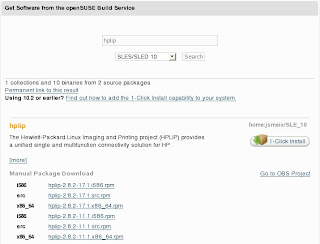This entry is prompted by my previous entry for openSUSE 11 (
link). I recall that I had similar challenges in setting up my home
HP Deskjet F2120 printer with SLED 10 SP2. With SLED 10 SP2, the challenge was the bundled
hplip driver was of a much older version and did not have the necessary support for newer HP Printers.
With an enterprise product (ie 7 years support), Novell had to keep its SUSE Linux Enterprise Desktop (aka SLED) 10 in a fairly "stable and supportable" state. Therfore, its kernel (2.6.16) and its associated packages are mostly static (unless there is a security or mandatory patch).Unfortunately (for me), this means the hplip is at version 0.9.7 and another alternative version at 1.7.2. The latest hplip from source is at version 2.8.5 (as of this writing).
Here's how I got my SLED 10 SP2 to work with my new HP Deskjet F2120.
Note: You are on your own as the steps below will install a newer hplip version that does not come with the official SLED 10 SP2 package... Ergo, outside the official enterprise support scope.
1) Use
Firefox to surf to
openSUSE Build Service at
http://software.opensuse.org/search2) In the search field, enter
hplip and select
SLES/SLED 10 in the drop-down list and click
Search3) From the results, as shown below, note that there is a version 2.8.2 of hplip available.
 Note:
Note: Do
NOT click the 1-Click Install button. The default SLED 10 does not support this feature... most likely available in the SLED 11 timeframe.

4) Instead, take note of the line above the 1-Click Install button (ie
home:jsmeix/SLE_10). You can do so by
right-clicking on (
home:jsmeix/SLE_10) and select
Copy Link Location.
The actual URL link is
http://download.opensuse.org/repositories/home:jsmeix/SLE_105) Start
YaST ->
Installation Source. Select
Add, followed by
Specify URL... and click
Next.
Paste the link in step (4) in the URL field and click
Next. After YaST downloads the respective meta-data and creates a new installation source, click
Finish.
6) Start
YaST ->
Software Management. Enter
hplip in the
Search field. You will see the hplip package but a newer 2.8.2 version is available for installation. Select this newer hplip version and install or update (if you have a previous hplip version installed).
OOPS: You will need to
re-install yast2-printer package. If you do not re-install, the YaST Printer module will hang while it re-organize its new printer database (you installed a new hplip). A re-installation of yast2-printer will overcome this problem.

7) Plug in the USB connector of the HP Deskjet F2120 and use the
Control Center -> Printers to configure and you will find the driver for F2120 is now available.
TIP: To monitor all printer definitions, status and print jobs. Use Firefox with the following link http://localhost:631
Viola! Happiness...









